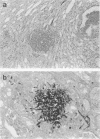Abstract
Serious infections caused by Trichosporon beigelii have been noted with increasing frequency in immuno-compromised patients. Progress in understanding the pathogenesis of this emerging infection has been limited by the lack of an animal model. We developed a CF1 mouse intravenous inoculation model of disseminated trichosporonosis to evaluate the pathogenicity of T. beigelii in transiently immunosuppressed mice. Four inocula (1 x 10(6), 1 x 10(7), 2 x 10(7), and 4 x 10(7) CFU per animal) of one clinical strain of T. beigelii 3001 were tested. Mice in groups of 10 were each injected with a single intravenous dose of one inoculum. Mortality correlated with inoculum size, as survival time was significantly shorter in mice injected with 4 x 10(7) or 2 x 10(7) CFU than in mice that received 1 x 10(7) or 1 x 10(6) CFU (P less than 0.01). Necrotizing abscesses with conidial and hyphal elements and neutrophil and macrophage infiltration were observed in all major organs examined. Resistance to infection was markedly lowered by immunosuppression with either cyclophosphamide or cortisone acetate, with a significantly shorter survival time and a greater fungal burden per organ in immunosuppressed animals than in normal animals (P less than 0.01). Nine additional strains were inoculated intravenously with around 5 x 10(6) CFU. Injection of each of these strains caused 100% mortality, in a pattern similar to that observed with strain 3001.
Full text
PDF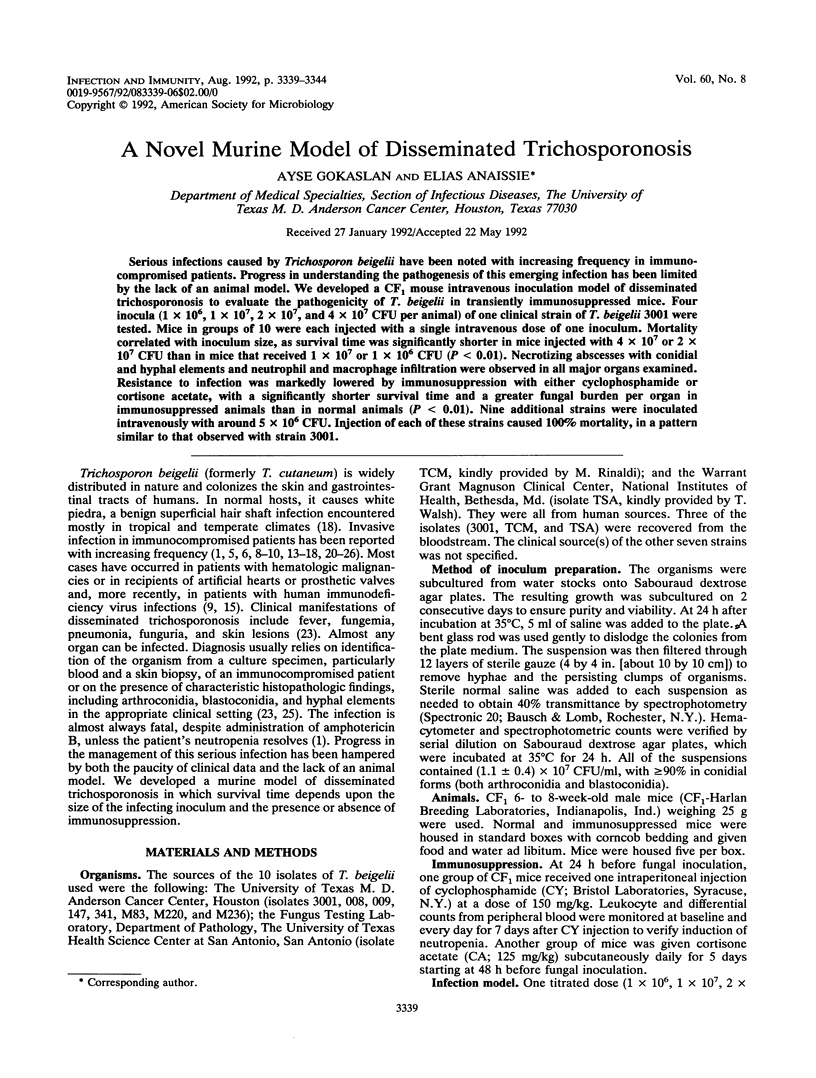
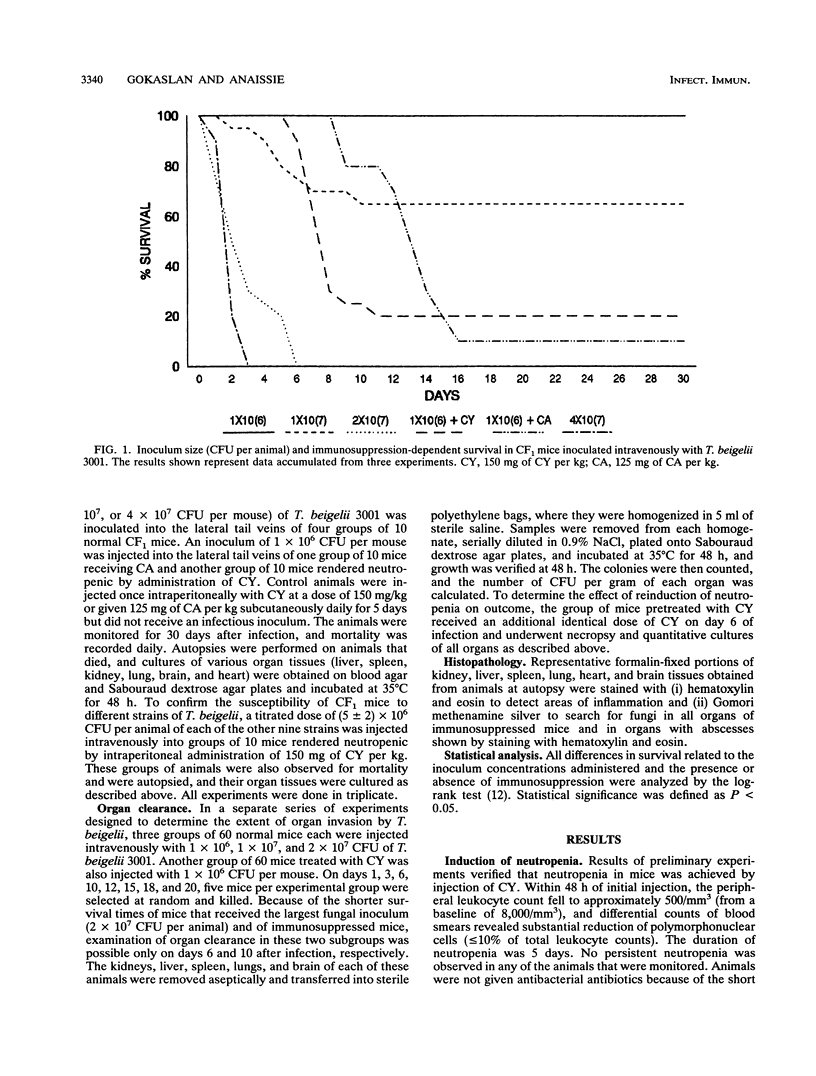
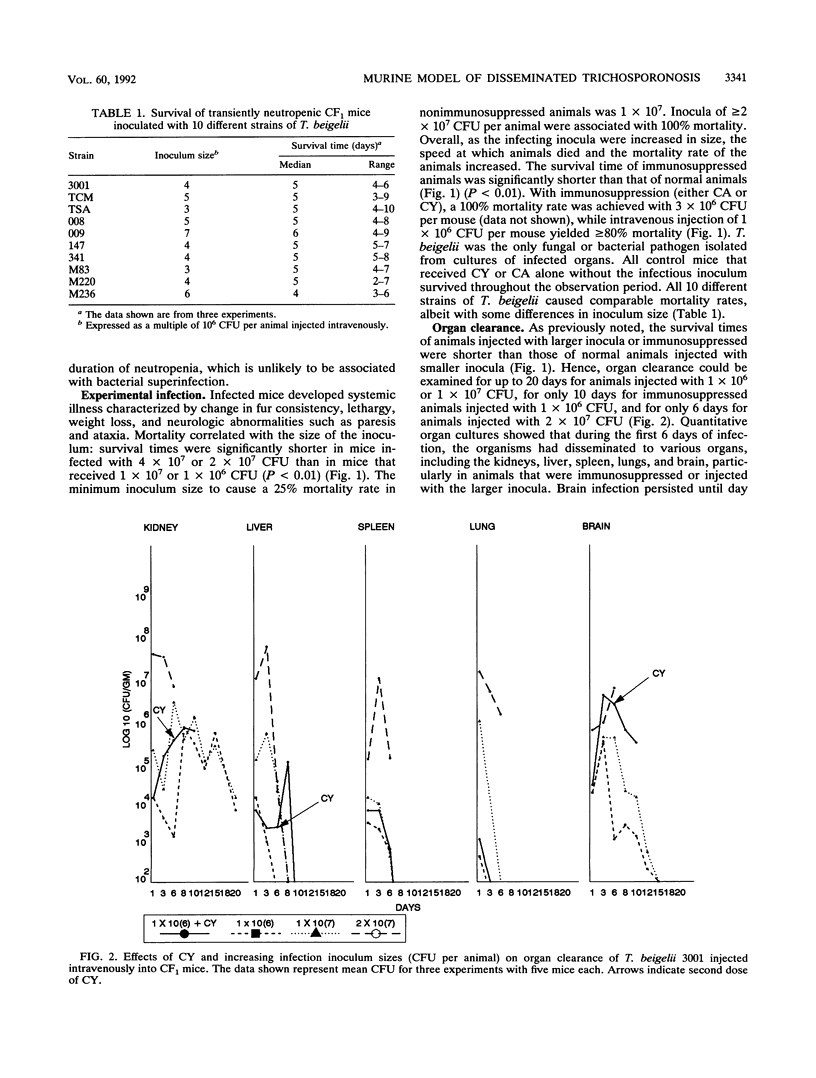
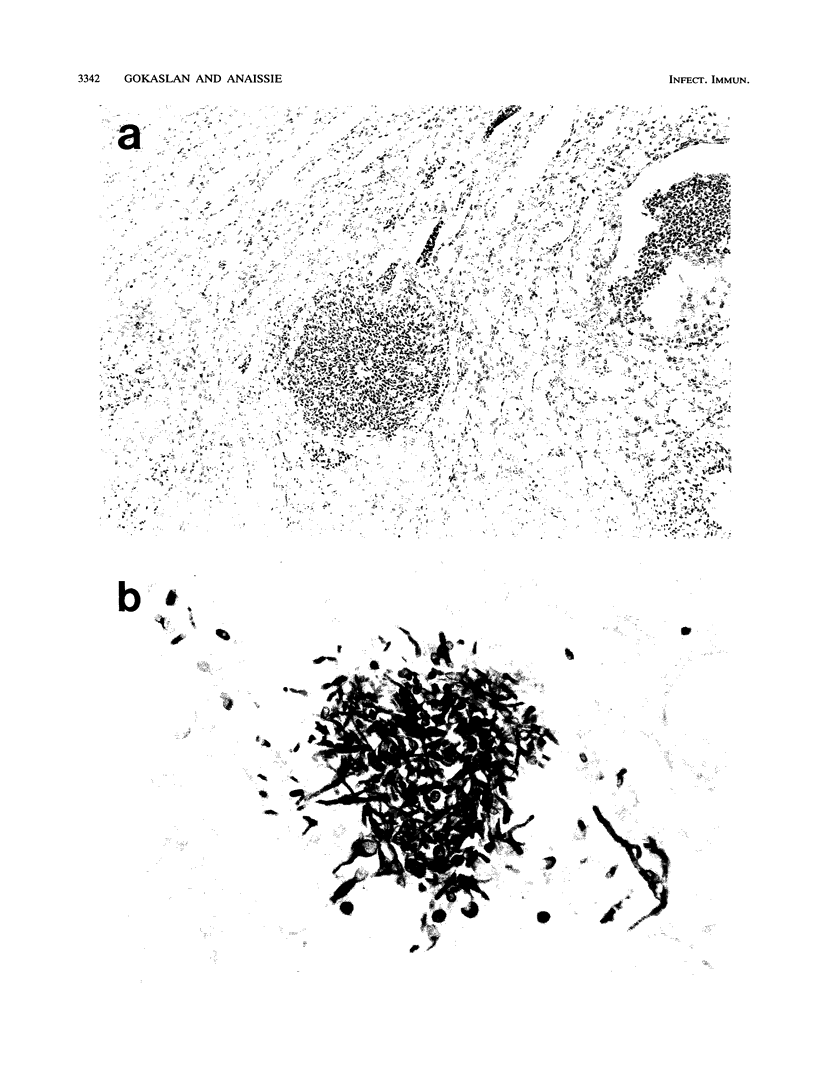
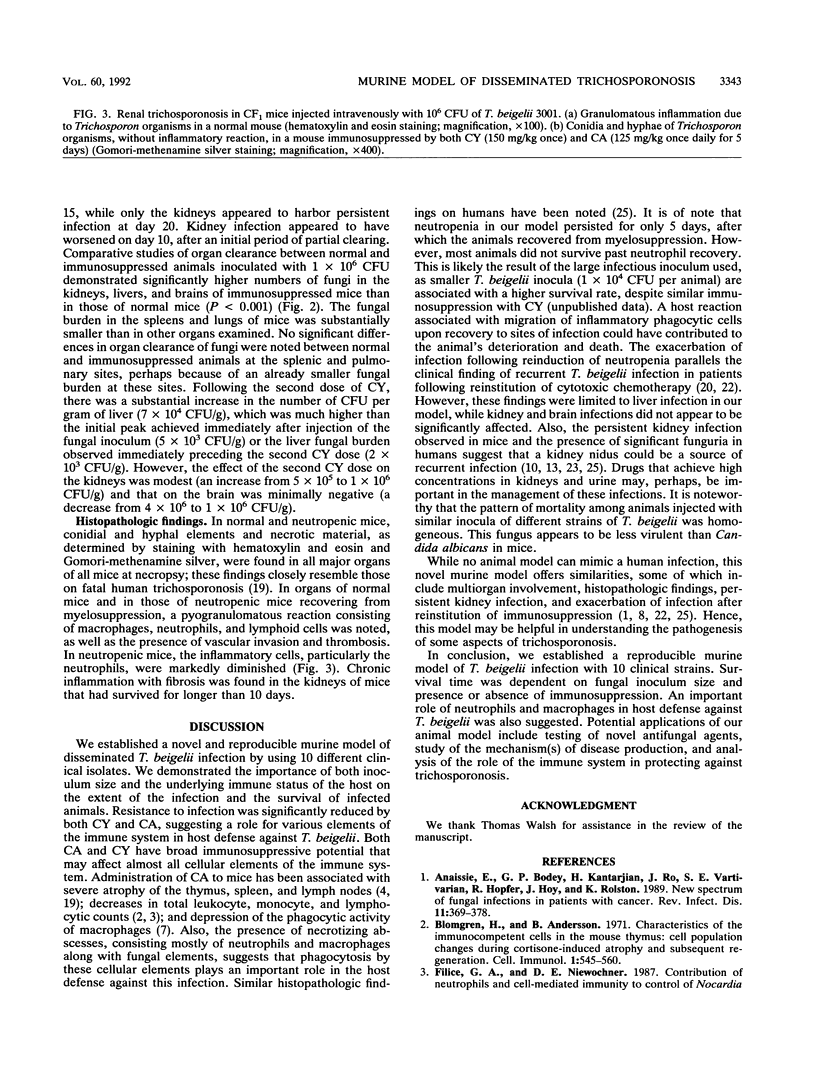
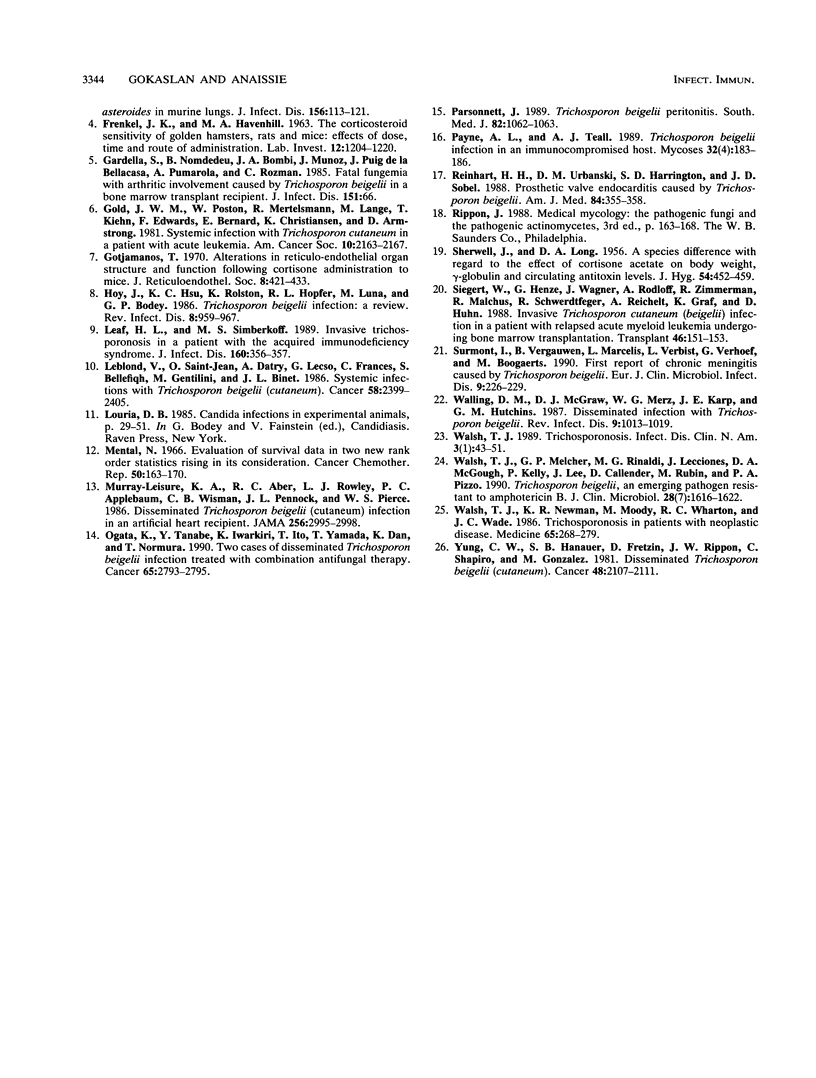
Images in this article
Selected References
These references are in PubMed. This may not be the complete list of references from this article.
- Anaissie E., Bodey G. P., Kantarjian H., Ro J., Vartivarian S. E., Hopfer R., Hoy J., Rolston K. New spectrum of fungal infections in patients with cancer. Rev Infect Dis. 1989 May-Jun;11(3):369–378. doi: 10.1093/clinids/11.3.369. [DOI] [PubMed] [Google Scholar]
- Blomgren H., Andersson B. Characteristics of the immunocompetent cells in the mouse thymus: cell population changes during cortisone-induced atrophy and subsequent regeneration. Cell Immunol. 1970 Nov;1(5):545–560. doi: 10.1016/0008-8749(70)90041-9. [DOI] [PubMed] [Google Scholar]
- FRENKEL J. K., HAVENHILL M. A. THE CORTICOID SENSITIVITY OF GOLDEN HAMSTERS, RATS, AND MICE. EFFECTS OF DOSE, TIME, AND ROUTE OF ADMINISTRATION. Lab Invest. 1963 Dec;12:1204–1220. [PubMed] [Google Scholar]
- Filice G. A., Niewoehner D. E. Contribution of neutrophils and cell-mediated immunity to control of Nocardia asteroides in murine lungs. J Infect Dis. 1987 Jul;156(1):113–121. doi: 10.1093/infdis/156.1.113. [DOI] [PubMed] [Google Scholar]
- Gold J. W., Poston W., Mertelsmann R., Lange M., Kiehn T., Edwards F., Bernard E., Christiansen K., Armstrong D. Systemic infection with Trichosporon cutaneum in a patient with acute leukemia: report of a case. Cancer. 1981 Nov 15;48(10):2163–2167. doi: 10.1002/1097-0142(19811115)48:10<2163::aid-cncr2820481008>3.0.co;2-t. [DOI] [PubMed] [Google Scholar]
- Gotjamanos T. Alterations in reticuloendothelial organ structure and function following cortisone administration to mice. J Reticuloendothel Soc. 1970 Nov;8(5):421–433. [PubMed] [Google Scholar]
- Hoy J., Hsu K. C., Rolston K., Hopfer R. L., Luna M., Bodey G. P. Trichosporon beigelii infection: a review. Rev Infect Dis. 1986 Nov-Dec;8(6):959–967. [PubMed] [Google Scholar]
- LONG D. A., SHEWELL J. A species difference with regard to the effect of cortisone acetate on body weight, gamma-globulin and circulating antitoxin levels. J Hyg (Lond) 1956 Dec;54(4):452–460. doi: 10.1017/s0022172400044739. [DOI] [PMC free article] [PubMed] [Google Scholar]
- Leaf H. L., Simberkoff M. S. Invasive trichosporonosis in a patient with the acquired immunodeficiency syndrome. J Infect Dis. 1989 Aug;160(2):356–357. doi: 10.1093/infdis/160.2.356. [DOI] [PubMed] [Google Scholar]
- Leblond V., Saint-Jean O., Datry A., Lecso G., Frances C., Bellefiqh S., Gentilini M., Binet J. L. Systemic infections with Trichosporon beigelii (cutaneum). Report of three new cases. Cancer. 1986 Dec 1;58(11):2399–2405. doi: 10.1002/1097-0142(19861201)58:11<2399::aid-cncr2820581108>3.0.co;2-y. [DOI] [PubMed] [Google Scholar]
- Mantel N. Evaluation of survival data and two new rank order statistics arising in its consideration. Cancer Chemother Rep. 1966 Mar;50(3):163–170. [PubMed] [Google Scholar]
- Murray-Leisure K. A., Aber R. C., Rowley L. J., Applebaum P. C., Wisman C. B., Pennock J. L., Pierce W. S. Disseminated Trichosporon beigelii (cutaneum) infection in an artificial heart recipient. JAMA. 1986 Dec 5;256(21):2995–2998. [PubMed] [Google Scholar]
- Ogata K., Tanabe Y., Iwakiri K., Ito T., Yamada T., Dan K., Nomura T. Two cases of disseminated Trichosporon beigelii infection treated with combination antifungal therapy. Cancer. 1990 Jun 15;65(12):2793–2795. doi: 10.1002/1097-0142(19900615)65:12<2793::aid-cncr2820651231>3.0.co;2-s. [DOI] [PubMed] [Google Scholar]
- Parsonnet J. Trichosporon beigelii peritonitis. South Med J. 1989 Aug;82(8):1062–1063. doi: 10.1097/00007611-198908000-00037. [DOI] [PubMed] [Google Scholar]
- Payne A. L., Teall A. J. Trichosporon beigelii infection in an immunocompromised host. Mycoses. 1989 Apr;32(4):183–186. doi: 10.1111/j.1439-0507.1989.tb02228.x. [DOI] [PubMed] [Google Scholar]
- Reinhart H. H., Urbanski D. M., Harrington S. D., Sobel J. D. Prosthetic valve endocarditis caused by Trichosporon beigelii. Am J Med. 1988 Feb;84(2):355–358. doi: 10.1016/0002-9343(88)90440-8. [DOI] [PubMed] [Google Scholar]
- Siegert W., Henze G., Wagner J., Rodloff A., Zimmermann R., Malchus R., Schwerdtfeger R., Reichelt A., Gräf K., Huhn D. Invasive Trichosporon cutaneum (beigelii) infection in a patient with relapsed acute myeloid leukemia undergoing bone marrow transplantation. Transplantation. 1988 Jul;46(1):151–153. [PubMed] [Google Scholar]
- Surmont I., Vergauwen B., Marcelis L., Verbist L., Verhoef G., Boogaerts M. First report of chronic meningitis caused by Trichosporon beigelii. Eur J Clin Microbiol Infect Dis. 1990 Mar;9(3):226–229. doi: 10.1007/BF01963845. [DOI] [PubMed] [Google Scholar]
- Walling D. M., McGraw D. J., Merz W. G., Karp J. E., Hutchins G. M. Disseminated infection with Trichosporon beigelii. Rev Infect Dis. 1987 Sep-Oct;9(5):1013–1019. doi: 10.1093/clinids/9.5.1013. [DOI] [PubMed] [Google Scholar]
- Walsh T. J., Melcher G. P., Rinaldi M. G., Lecciones J., McGough D. A., Kelly P., Lee J., Callender D., Rubin M., Pizzo P. A. Trichosporon beigelii, an emerging pathogen resistant to amphotericin B. J Clin Microbiol. 1990 Jul;28(7):1616–1622. doi: 10.1128/jcm.28.7.1616-1622.1990. [DOI] [PMC free article] [PubMed] [Google Scholar]
- Walsh T. J., Newman K. R., Moody M., Wharton R. C., Wade J. C. Trichosporonosis in patients with neoplastic disease. Medicine (Baltimore) 1986 Jul;65(4):268–279. doi: 10.1097/00005792-198607000-00005. [DOI] [PubMed] [Google Scholar]
- Yung C. W., Hanauer S. B., Fretzin D., Rippon J. W., Shapiro C., Gonzalez M. Disseminated Trichosporon beigelii (cutaneum). Cancer. 1981 Nov 1;48(9):2107–2111. doi: 10.1002/1097-0142(19811101)48:9<2107::aid-cncr2820480932>3.0.co;2-l. [DOI] [PubMed] [Google Scholar]



